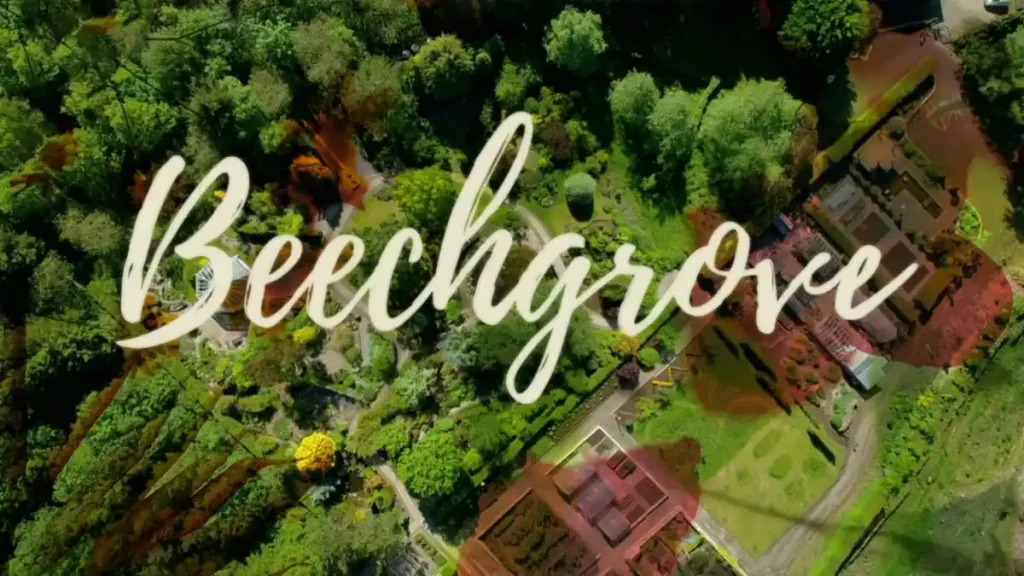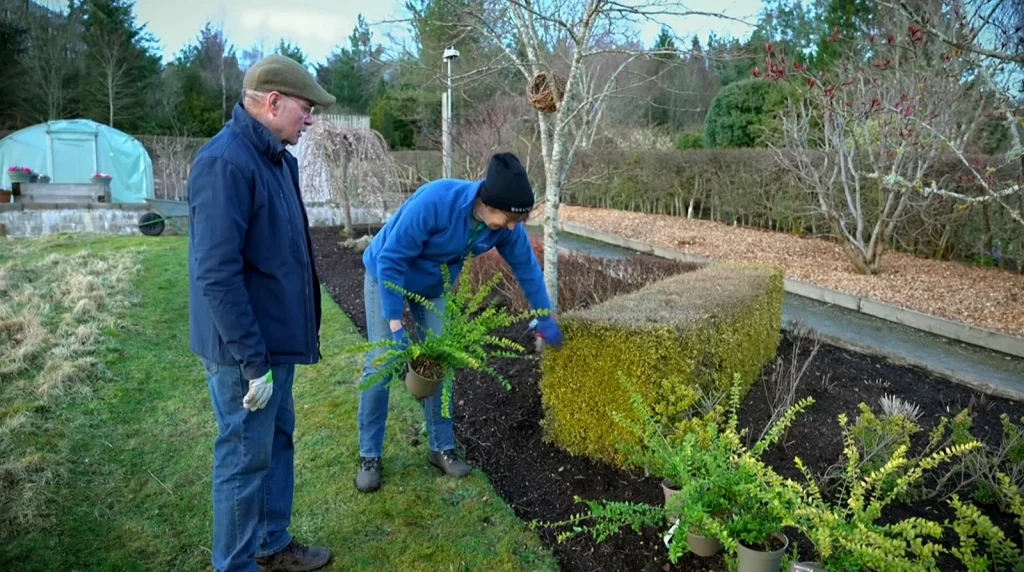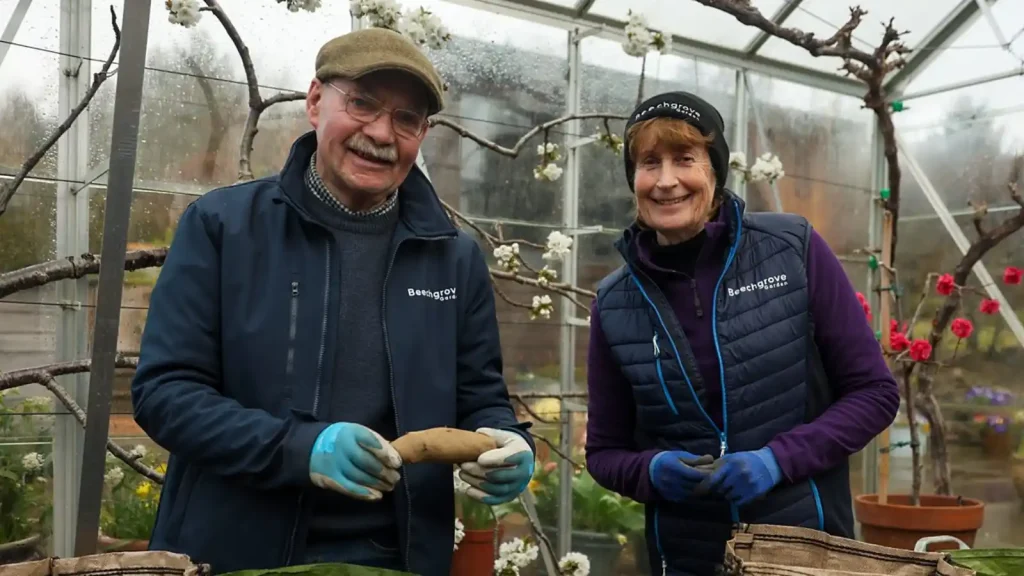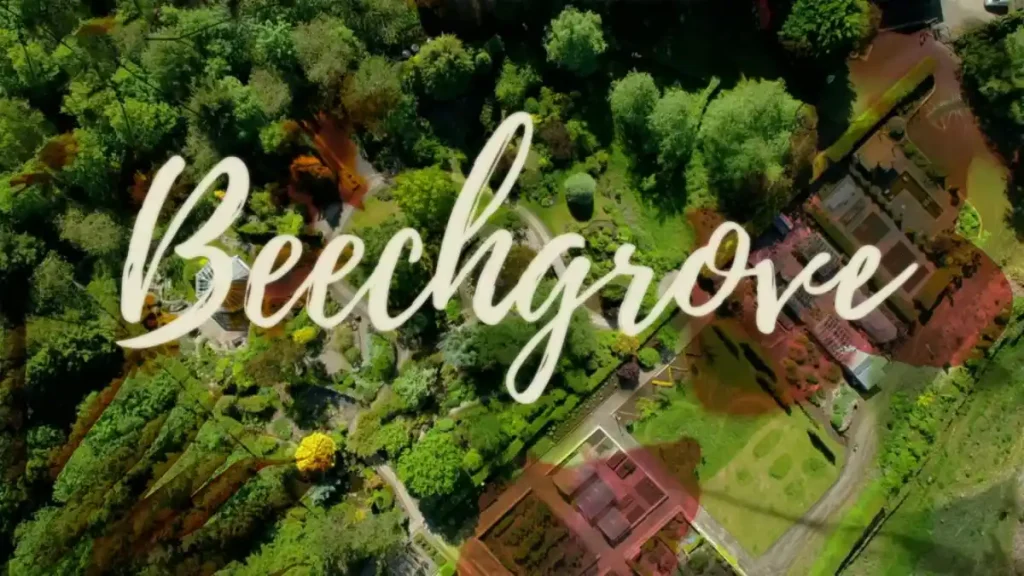The Beechgrove Garden 2024 episode 13: This week at Beechgrove Garden, experience the pure delight of stepping into your own garden to harvest something fresh and sweet. Join experts George Anderson and Calum Clunie as they dedicate their expertise to nurturing vines, figs, and an assortment of fruit bushes, bringing to life the essence of a thriving garden.
George Anderson will be your guide inside the fruit house, where he shares his seasoned techniques for maximizing the yield and health of your grapevines. His passion for gardening shines through as he introduces new varieties of gooseberries, blackcurrants, and redcurrants in the fruit cage. Not stopping there, George will also demonstrate the art of pruning Beechgrove’s venerable plum trees, ensuring their health and productivity for seasons to come.
Meanwhile, Calum Clunie takes you through the rhythms of the vegetable patch, revealing the secrets behind this year’s successful successional sowing. His hands-on approach not only highlights the practical aspects of vegetable cultivation but also encourages gardeners to think strategically to ensure a continuous and bountiful harvest throughout the growing season.
In addition to these focused activities, this episode will offer a plethora of handy hints that are indispensable for both novice and experienced gardeners. These tips are designed to enhance your gardening skills and deepen your understanding of plant care.
Join us for episode 13 of the Beechgrove Garden 2024 series, where the joy of gardening comes to life through expert guidance and practical advice, tailored to help your garden flourish. Whether you’re looking to refine your techniques or simply draw inspiration from the beauty of well-tended nature, this episode is a must-watch for everyone who loves to get their hands dirty in the pursuit of gardening excellence.
The Beechgrove Garden 2024 episode 13
Mastering the Art of Plum Tree Pruning: A Comprehensive Guide
Understanding the Importance of Pruning Plum Trees
Pruning plum trees is a crucial aspect of maintaining healthy, productive fruit trees in your garden. While plums don’t require the same level of precise pruning as apples and pears, they still benefit significantly from proper training and regular maintenance. We’ve found that well-pruned plum trees not only produce more fruit but also maintain better overall health and structure.
The Benefits of Proper Plum Tree Pruning
When we prune plum trees correctly, we achieve several important goals:
- Improved air circulation and sunlight penetration
- Enhanced fruit production and quality
- Reduced risk of disease and pest infestations
- Maintenance of an ideal tree shape and size
- Removal of dead, damaged, or diseased wood
By understanding these benefits, we can approach plum tree pruning with confidence and purpose, ensuring our trees thrive year after year.
Timing Your Plum Tree Pruning
One of the most critical aspects of pruning plum trees is getting the timing right. Unlike many other fruit trees, plums are particularly susceptible to silver leaf disease, which can enter through pruning wounds. To minimize this risk, we always adhere to specific pruning schedules.
The Ideal Seasons for Pruning Plums
We’ve found that the best times to prune plum trees are:
- Early spring (April): This is ideal for young trees and for major structural pruning.
- Mid-summer (July): Perfect for established trees and light maintenance pruning.
It’s crucial to avoid pruning plums in winter, as this significantly increases the risk of silver leaf disease infection. By sticking to these recommended pruning times, we can help ensure the health and longevity of our plum trees.
Choosing the Right Pruning Method for Your Plum Tree
There are several methods we can use when pruning plum trees, each suited to different growing conditions and desired tree shapes. The three most common methods are bush, pyramid, and fan pruning, with cordon training gaining popularity in recent years.
The Bush Pruning Method
Bush pruning is perhaps the most popular method for training and pruning plum trees. This technique creates an open-centered tree with a clear stem of about 75cm (2½ft). The ultimate size of the tree will depend on the rootstock used:
- ‘Pixy’ rootstock: Trees reach about 3m (10ft)
- ‘St. Julien A’ rootstock: Trees grow to 3.6-4.5m (13-15ft)
- ‘Brompton’ and ‘Myrobalan B’ rootstocks: Trees can reach up to 6m (20ft)
When using the bush pruning method, we aim to create an open-centered tree that allows for good air circulation and sunlight penetration. This begins with formative pruning in early spring, similar to that used for apples and pears.
The Pyramid Pruning Method
Pyramid pruning results in a smaller tree than the bush method, making it ideal for gardens with limited space or for those who want to net their trees against birds. We typically keep plums on ‘St. Julien A’ rootstocks to 2.4m (8ft) and those on ‘Pixy’ rootstocks to 1.8m (6ft) when using this method.
The initial pruning of a newly planted tree follows the same process as for apples and pears, but it’s crucial to remember to carry out this pruning in April, not winter, to avoid silver leaf disease.
The Fan Pruning Method
Fan pruning is an excellent choice for training plum trees against walls or fences. This method creates a fan-shaped tree, with horizontal wires fixed 15cm (6in) apart to support the branches. We can purchase trees as maidens or partly trained for this purpose.
When using the fan pruning method, we can expect trees on ‘Pixy’ rootstock to reach a height and spread of 3m (10ft) by 2m (6½ft), while trees on ‘St. Julian A’ rootstock typically grow to 3.6m (12ft) by 2.4m (8ft).
Step-by-Step Guide to Pruning Plum Trees
Now that we’ve covered the different pruning methods, let’s dive into a step-by-step guide for pruning plum trees effectively.
Initial Formative Pruning
- Begin pruning in early spring (April) for young trees.
- Remove any competing central leaders, leaving one strong, upright stem.
- Cut back the main stem by about one-third to encourage branching.
- Select 3-5 well-spaced branches to form the main framework, removing any others.
- Shorten these selected branches by about one-third, cutting to an outward-facing bud.
Ongoing Maintenance Pruning
- In mid-summer (July), remove any dead, diseased, or damaged wood.
- Thin out overcrowded branches to improve air circulation.
- Cut back any excessively long or vigorous shoots to maintain the desired tree shape.
- Remove any suckers growing from the rootstock.
- Prune out any branches growing towards the center of the tree.
Pruning Established Trees
- Focus on maintaining an open, vase-like structure.
- Remove any crossing or rubbing branches.
- Thin out fruiting spurs if they become overcrowded.
- Shorten branch leaders by about one-quarter, cutting to an outward-facing bud.
- Reduce the height of the tree if necessary by cutting back to a lower branch or bud.
Dealing with Neglected and Overgrown Plum Trees
Renovating an old, neglected plum tree requires patience and a staged approach over several years. Our goal is to create a well-balanced tree while encouraging new growth and maintaining fruit production.
Renovation Pruning Techniques
- Begin by removing any dead, diseased, or damaged wood.
- Thin out overcrowded branches, focusing on those in the center of the crown.
- Cut back overly long branches to encourage new growth closer to the main trunk.
- Remove any branches that are crossing or rubbing against each other.
- Consider using the festooning technique to control vigor in large, unruly trees.
Festooning involves tying down young, flexible branches to a horizontal position during the summer months. This technique can help prevent trees from becoming overgrown and is particularly effective for pyramid plums.
Common Pruning Problems and Solutions
As we prune our plum trees, we may encounter some common issues. Here are some problems we’ve faced and the solutions we’ve found effective:
Dealing with Heavy Crops
Plums can be heavy croppers, which can lead to broken branches. To prevent this:
- Thin fruit clusters in early summer, leaving about 2-3 inches between fruits.
- Provide support for heavily laden branches using props or ties.
- Prune back broken branches to undamaged wood, ideally cutting back to a natural fork.
Addressing Bare Wood Areas
Bare wood can be challenging to remedy on fruit trees. Here are some techniques we’ve found useful:
- In spring, stimulate dormant buds by pruning back to just above the bare section.
- Use the notching technique to encourage growth in specific areas.
- Consider bridge grafting for larger areas of bare wood.
Managing Vigorous Growth
Overly vigorous growth can be a problem, especially in young trees. To manage this:
- Avoid over-fertilizing, which can promote excessive vegetative growth.
- Use summer pruning to control vigor and encourage fruit bud formation.
- Consider root pruning for extremely vigorous trees.
The Beechgrove Garden: A Flourishing Guide to Gardening in a Changing Climate
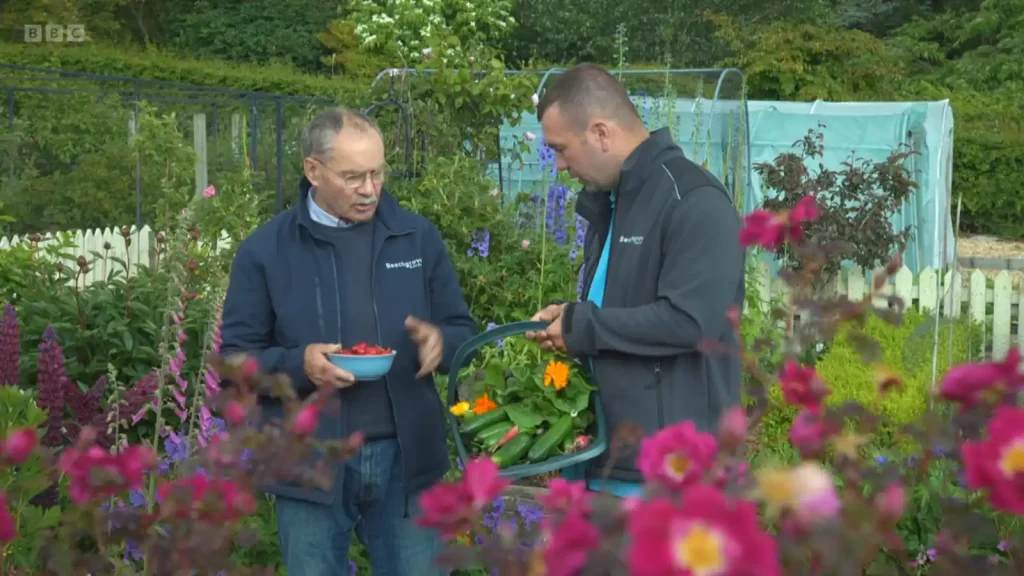
For decades, The Beechgrove Garden has been a beloved staple for Scottish gardeners, celebrating the country’s unique horticulture and offering invaluable growing advice. In 2024, the show continues its legacy, adapting to the evolving challenges posed by climate change while still inspiring viewers with the beauty and bounty of homegrown produce.
Season 2024: A Season of Adaptation
Hosted by the knowledgeable duo of Carole Baxter and George Anderson, the latest season delves into the aftermath of a particularly harsh Scottish winter. Viewers are taken on a journey through the Beechgrove Garden as the team assesses the impact of the wet and wild weather on the landscape, providing insight into how to revive and protect plants in similar conditions.
Throughout the season, episodes cover a broad spectrum of gardening topics, from nurturing delicate fig plants and fruit bushes to tending vibrant vines. Beginners and seasoned green thumbs alike will find valuable tips and techniques for cultivating their own gardens, regardless of size or experience level.
Accessibility and Global Reach
New episodes air weekly on BBC Scotland, and for those who prefer on-demand viewing, the entire season is available to stream on BBC iPlayer or HDclump.com. The show’s global audience can also access the series on HDclump.com, ensuring that gardening enthusiasts worldwide can benefit from the expertise shared by The Beechgrove Garden team.
Gardening in a Changing Climate: Key Themes
The 2024 season places a special emphasis on the undeniable impact of climate change on gardening practices. Several key themes emerge throughout the episodes:
- Weathering the Storm: The show explores in detail the effects of the recent harsh winter on the Beechgrove Garden. This serves as a case study for viewers, offering strategies to cope with similar challenges in their gardens.
- Building Resilience: The importance of selecting climate-resilient plants is a recurring theme. The Beechgrove Garden team shares their knowledge on choosing versatile varieties that can withstand increasingly unpredictable weather patterns.
- Showcasing Scotland’s Diversity: Recognizing the unique gardening conditions across the country, the 2024 season ventures beyond the familiar Beechgrove grounds. Episodes filmed in diverse locations offer region-specific advice and celebrate the richness of Scotland’s gardening landscape.
- Preparedness for Extremes: The show acknowledges the growing threat of extreme weather events, such as heavy rainfall, tropical storms, and even wildfires. Practical advice is shared to help viewers safeguard their gardens from these potential dangers.
- Adapting to the New Normal: The Beechgrove Garden team openly discusses the broader trends of rising temperatures and shifting climate patterns. The show encourages gardeners to embrace adaptable practices and experiment with new plant choices to thrive in a changing environment.
A Valuable Resource for the Modern Gardener
The Beechgrove Garden is more than just a television program; it is a trusted companion for gardeners navigating the complexities of climate change. The show’s commitment to providing practical, regionally relevant advice ensures that viewers are equipped with the knowledge and skills necessary to create flourishing gardens in an ever-evolving world.
F.A.Q. The Beechgrove Garden 2024 episode 13
Q.: What can viewers expect from George Anderson in episode 13 of the Beechgrove Garden 2024 series?
A.: In episode 13, George Anderson will guide viewers through the fruit house, sharing expert techniques for optimizing vine growth and health. He will also introduce new gooseberry, blackcurrant, and redcurrant cultivars in the fruit cage, demonstrating essential pruning methods to maintain the health and productivity of Beechgrove’s plum trees.
Q.: What are some of the hands-on activities that Calum Clunie will demonstrate in the vegetable patch?
A.: Calum Clunie will delve into the practicalities of successional sowing in the vegetable patch, showcasing his strategic approach to ensure a continuous and abundant harvest. His segment will highlight the importance of thoughtful vegetable cultivation, providing invaluable tips for gardeners aiming to enhance their growing techniques.
Q.: What type of practical advice will this episode offer to its viewers?
A.: Episode 13 of the Beechgrove Garden 2024 series is rich with practical advice, offering a variety of handy hints that cater to both novice and seasoned gardeners. These tips are tailored to improve gardening skills and deepen understanding of plant care, emphasizing the development of a thriving and sustainable garden.
Q.: How can viewers benefit from watching the Beechgrove Garden series?
A.: Viewers will benefit from expert guidance and practical advice tailored to help their gardens flourish. The series provides insights into effective gardening practices, from pruning techniques to crop rotation, helping viewers draw inspiration from the beauty of well-tended nature and refine their own gardening skills.
Q.: Where can audiences access the Beechgrove Garden 2024 series?
A.: The Beechgrove Garden 2024 series is available weekly on BBC Scotland. For those who prefer streaming, the series is accessible on-demand via the BBC iPlayer or HDclump.com. Additionally, international viewers can watch the episodes on HDclump.com, ensuring global access to the series’ extensive gardening knowledge and tips.
Conclusion The Beechgrove Garden 2024 episode 13
As the Beechgrove Garden team continues to guide us through the 2024 season, episode 13 serves as a testament to the show’s dedication to providing comprehensive gardening knowledge. From expert advice on plum tree pruning to showcasing the beauty and bounty of thriving vines, figs, and fruit bushes, this episode is packed with valuable insights and practical tips for gardeners of all levels.
Whether you’re a novice looking to learn the basics of pruning or an experienced gardener seeking to refine your techniques, the Beechgrove Garden team has you covered. Their hands-on approach and passion for horticulture shine through, making even the most complex gardening tasks accessible and enjoyable. The step-by-step guide to pruning plum trees, along with the troubleshooting tips for common problems, equips viewers with the knowledge and confidence to maintain healthy and productive fruit trees in their own gardens.
Beyond plum tree care, this episode celebrates the joy of harvesting fresh, homegrown produce. George Anderson and Calum Clunie’s expertise in nurturing vines, figs, and fruit bushes is evident, inspiring viewers to cultivate their own bountiful gardens. Calum Clunie’s insights on successional sowing in the vegetable patch further emphasize the importance of strategic planning for a continuous and abundant harvest throughout the growing season.
In essence, episode 13 of Beechgrove Garden 2024 is a celebration of gardening excellence, offering a blend of expert guidance, practical advice, and inspirational examples. It encapsulates the show’s core values of promoting sustainable gardening practices, adapting to the challenges of climate change, and fostering a deep connection with nature. By tuning in to this episode, you’ll not only gain valuable knowledge but also find renewed inspiration to nurture your own garden and reap the rewards of your labor.
So, join the Beechgrove Garden team on this journey of discovery and unlock the secrets to a flourishing garden that brings you joy and satisfaction for years to come.
